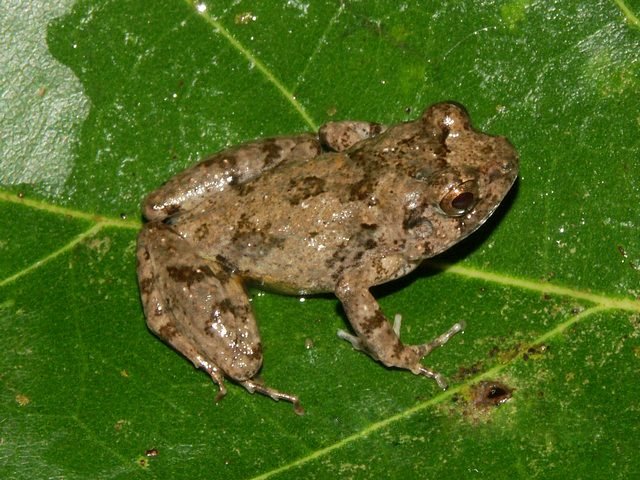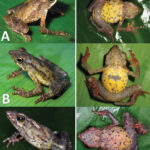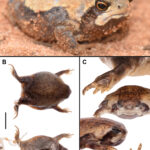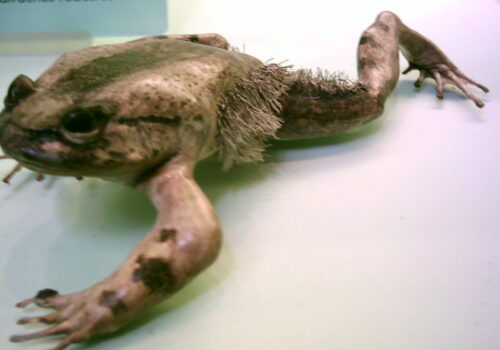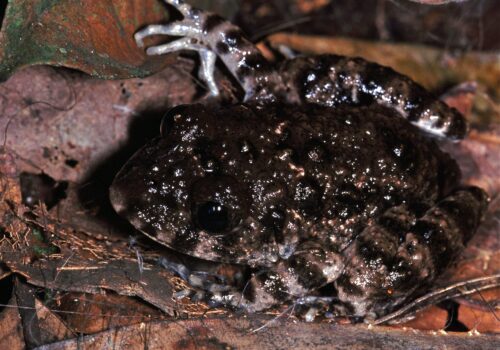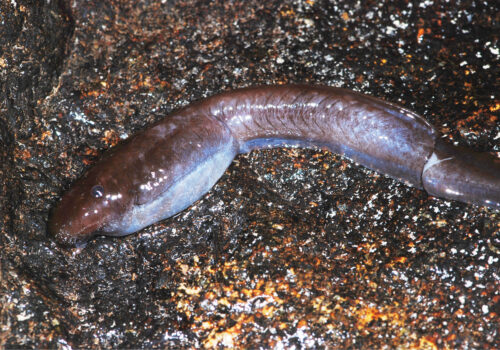- The Secret Life of <em>Arthroleptis adelphus</em>: Africa’s Hidden Rainforest Jewel
- Taxonomy and Classification: Understanding Its Place in Nature
- Natural Habitat: Rainforest Realm of Shadows and Dew
- Physical Characteristics: A Study in Subtle Beauty
- Behavior and Life Cycle: Secretive Lives Beneath Forest Canopies
- Ecological Role: Guardians and Indicators of Forest Health
- Threats and Conservation Status: Challenges in a Changing Landscape
- Cultural and Scientific Significance: Unveiling Mysteries of the Forest
- Conclusion: Safeguarding Hidden Rainforest Jewels
The Secret Life of Arthroleptis adelphus: Africa’s Hidden Rainforest Jewel#
Deep beneath the lush canopy of Central Africa’s ancient rainforests, a world largely unnoticed by human eyes thrives quietly; among its shadows and leaf-laden forest floor hides a small, fascinating amphibian known as Arthroleptis adelphus. Often overshadowed by charismatic megafauna, this tiny frog exemplifies the enigmatic charm and ecological intricacy of the rainforest ecosystem. Known to herpetologists and ecologists alike as a valuable bioindicator, Arthroleptis adelphus offers vital clues into the health and sustainability of their fragile habitat.
Embracing the lyrical sounds of nocturnal choruses on warm rainforest evenings, this shy and secretive amphibian challenges us to pause and appreciate the hidden wonders beneath our feet. Perhaps most intriguing is its delicate appearance, subtly masked great adaptability and resilience. Embark on an immersive journey through the shaded corridors and mossy logs that define the quiet existence of Arthroleptis adelphus.
Taxonomy and Classification: Understanding Its Place in Nature#
Arthroleptis adelphus is a proud representative of the family Arthroleptidae—a diverse group primarily found in Sub-Saharan Africa recognized for their intriguing direct-developing eggs and diverse morphologies. First described by Perret in 1966, this species belongs to the genus Arthroleptis, commonly known as squeaker frogs, due to the distinctive short and melodious sounds they emit during mating rituals and territorial displays.
Particularly closely related to species such as Arthroleptis variabilis and Arthroleptis brevipes, A. adelphus highlights evolutionary pathways unique to rainforest habitats. Its taxonomic classification provides valuable insight into the evolutionary forces that sculpt amphibian biodiversity within pristine forest ecosystems, becoming a fascinating subject for biological and ecological research alike.
Natural Habitat: Rainforest Realm of Shadows and Dew#
Geographic Distribution#
Constricted to a relatively restricted range deep within Central African forests, Arthroleptis adelphus is primarily confined to the dense forests of Cameroon, Equatorial Guinea, and, potentially, adjacent regions of Gabon or the Republic of Congo. Within these remote areas, dense foliage, high humidity, and vast canopies shelter thriving populations rarely glimpsed by the human eye.
Forest Floor Specialists: Adaptations to a Hidden World#
The frog thrives best concealed among leaf litter and decaying wood, within humid microhabitats shaded from direct sunlight and buffered from temperature extremes. Such sheltered niches protect it from predation and offer ideal conditions for its delicate skin to absorb moisture and oxygen—a vital capability for respiration in amphibians.
Under dense rainforest canopies, where giant trees stretch their crowns skyward and create a twilight sanctuary, intricate ecosystems unfold on the forest floor—moss-covered logs, carpets of fallen leaves, and a blanket of fungi supporting countless hidden creatures. Navigating this habitat, A. adelphus capitalizes on the saturated air and leaf-litter microclimate, perfectly suited to retaining moisture and facilitating survival away from permanent water sources.
Physical Characteristics: A Study in Subtle Beauty#
At merely two to three centimeters in average length, this minute frog exemplifies natural discretion and subtlety. Its compact body and relatively short limbs complement a ground-dwelling lifestyle, affording agility crucial for navigating the complexities of its forest habitat. A close look reveals patterns of intricate mottling of browns, grays, and ochres, perfectly matching the color-tones of the leaf litter beneath them—Nature’s most practical camouflage.
This cryptic coloration enables A. adelphus to blend seamlessly with fallen leaves, bark, and soil, suggesting an evolutionary legacy shaped by predation pressures. Intricately patterned skin not only camouflages the frog but indicates the health and ecological balance of their habitat, as skin condition and coloration can often mirror environmental changes and threats, lending wildlife conservationists insights into overall ecosystem health.
Behavior and Life Cycle: Secretive Lives Beneath Forest Canopies#
Feeding Habits: Silent Predators Among Leaves#
A stealthy insectivore, A. adelphus primarily preys upon small arthropods: ants, beetles, mites, and spiders make up most of their diet. With deliberate precision, they rely upon movement detection rather than vision alone. With rapid, darting movements—unseen to untrained human eyes—they capture prey under cover of darkness. Every night’s success contributes significantly to regulating insect populations, keeping arthropod communities in ecological balance.
Reproduction and Direct Development: Forgoing the Tadpole Stage#
One of the most fascinating evolutionary adaptions in Arthroleptidae frogs, like our own subject, is their remarkable direct development. Instead of depositing eggs in water bodies as many frogs traditionally do, A. adelphus lays eggs within moist leaf litter. Here, sheltered amidst damp organic matter, tiny embryos develop directly into miniature froglets—completely bypassing a vulnerable aquatic larval stage.
This developmental adaptation removes dependence upon water bodies, allowing populations to thrive independently within expansive terrestrial habitats. This remarkably innovative evolution enables the colonization of otherwise inhospitable environments, significantly enhancing their ecological versatility, survival rates, and habitat selection flexibility.
Ecological Role: Guardians and Indicators of Forest Health#
Amphibians such as A. adelphus provide deeper insights into environmental integrity precisely due to their sensitive skin and their susceptibility to environmental stressors. As predator and prey alike, the species contributes to controlling insect populations and providing food sources for birds, larger amphibians, and small mammals.
Because these frogs breathe partially through permeable skin, toxins and pollutants in the environment quickly translate into declining amphibian health or population reductions. Thus, the thriving presence of healthy populations of Arthroleptis adelphus often strongly correlates with ecosystems in good ecological shape, becoming ecological sentinels that profoundly help gauge rainforest stability, health, and biodiversity.
Threats and Conservation Status: Challenges in a Changing Landscape#
Currently listed by the International Union for Conservation of Nature (IUCN) as Least Concern, Arthroleptis adelphus inhabits regions largely untouched by intensive human settlement. However, emerging threats loom: escalating deforestation, climate variability, traditional agriculture techniques shifting toward industrial practices, and inadvertent pollution gradually impact many Central African pristine habitats.
These coral reef-like forests, embodying enormous biodiversity, face encroachment pressures, placing amphibians at risk given their delicate biological requirements. Conservation initiatives prioritizing habitat preservation, regulated logging, and environmental awareness offer a meaningful path forward in safeguarding not only A. adelphus but entire ecosystems and communities sharing these forests.
Cultural and Scientific Significance: Unveiling Mysteries of the Forest#
Though often overshadowed by conspicuous wildlife, amphibians such as A. adelphus feature prominently within local cultural narratives and are perceived as indicators of natural vitality by communities closely connected to the land. Scientifically, these frogs represent promising avenues of investigation into evolutionary adaptation to terrestrial life stages. Moreover, understanding their incredible resistance and susceptibility to environmental stressors guides ecological restoration projects and broad conservation strategies across Central Africa.
Conclusion: Safeguarding Hidden Rainforest Jewels#
The fascinating narrative of Arthroleptis adelphus reveals more than mere curiosity—it unfolds critical biological lessons concerning rainforest ecosystems and the urgent necessity for conservation action. By appreciating and understanding this unobtrusive yet profoundly significant amphibian, we join an essential movement toward responsible stewardship of our natural world.
Together, let us commit to safeguarding these tiny ambassadors of rainforest health. Through continued learning, advocacy, and global awareness, we may ensure that future generations marvel at the cryptic delights echoing quietly under Central Africa’s dense, emerald canopies.


